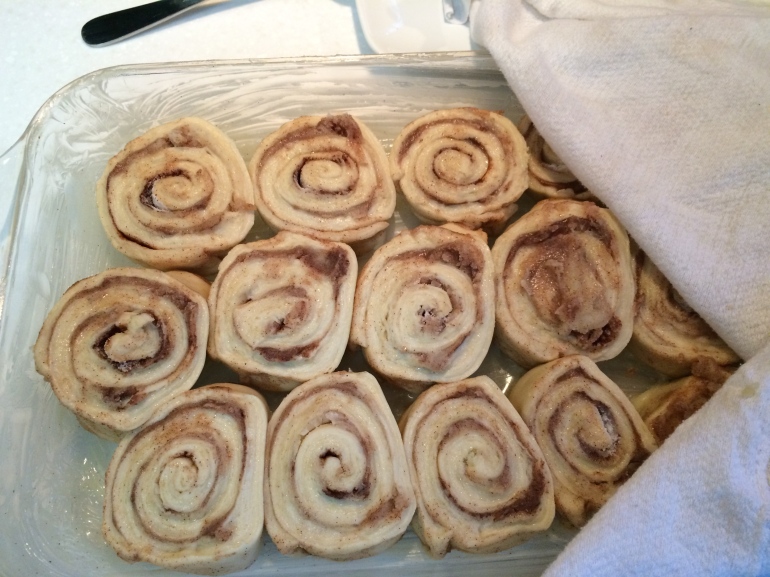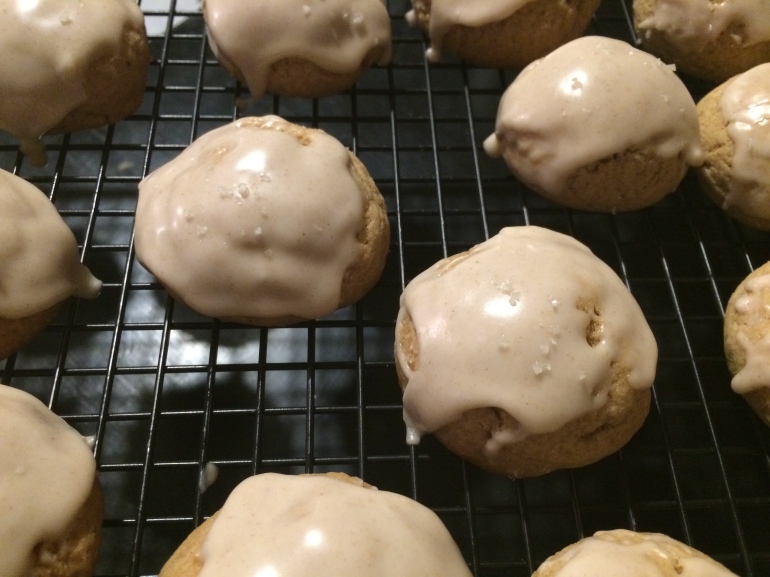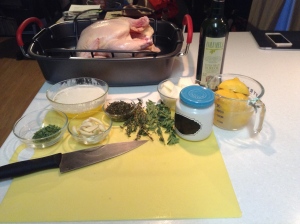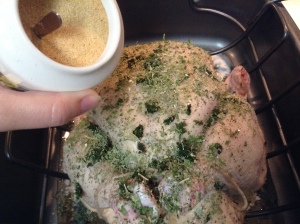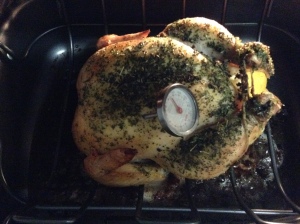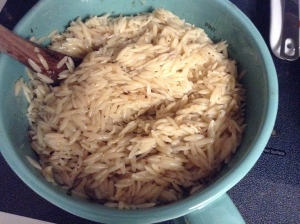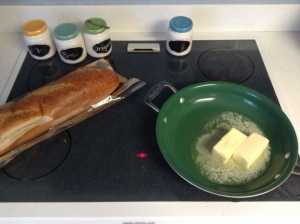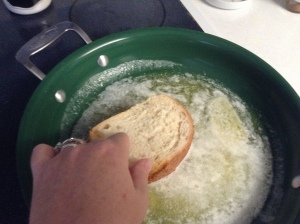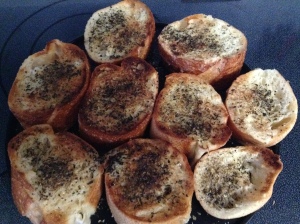This is the second installment of my four-part series, reviewing the recipes I tried for the first time this holiday season. In Review 1, I covered Christmas Spice Cookies, Whiskey Caramel Sauce and Candied “Limoncello” Peel. Now, let’s take a look at Cinnamon Rolls with Cream Cheese Icing, Breakfast “Cupcakes” and Blueberry Lemon Bundt Cake.
Cinnamon Rolls with Cream Cheese Icing (adapted from Pioneer Woman)

Listen, I don’t want to pat myself on the back or anything, but these things were freaking amazing. Neither my husband nor I could stop eating them. We had a slap fight over the last of them. That said, these suckers are not quick, easy or low in calories. So, this is definitely a special-occasion recipe. But, holy cannoli, so worth it.
I did not alter anything about the recipe for the rolls themselves. In fact, I followed the recipe to the letter, because this was one of my first attempts at working with yeast that didn’t involve an actual bread maker. The only deviation was the milk – I didn’t have a full quart of milk, so I used heavy cream and about 1/2 cup of buttermilk. Given the results, I would do it again.
And where the Pioneer Woman says not to be shy about the butter or the sugar, I was most definitely not. I do not know how much sugar and cinnamon I ended up using, but I did use four full sticks of butter. (Now, stop it. I made 32 cinnamon rolls, and some of that was used to grease the baking dishes …)
Can I say also that any recipe calling for “punching” anything as part of the prep is a winner in my book. I left the dough in the fridge overnight. In the morning, it had risen considerable. I did, in fact, punch it. Cathartic. Especially at 6:00 a.m. on a vacation day.
A few notes on slicing and baking off:
- When I sliced my rolls, I got 18 rolls from the first log of dough and 16 rolls from the second. The recipe states that each log should yield 20 – 25 rolls. I think you’d either have to roll the dough too thin or cut the rolls too thin to get that yield. I rolled the dough to about 1/4″ thick, and I cut the rolls about 3/4″ thick.
- For the baking, the recipe recommends placing the rolls in pie pans, but I didn’t have enough handy, so I put the rolls into 9 x 13 baking dishes. I tried not to pack the rolls in too tightly, but they were touching. The effect was to increase the cooking time from 18 minutes to about 25 minutes. I took them out when all the rolls had a nice golden brown top and the butter on the sides of the pan was bubbly. The centermost rolls were slightly doughier than the outer rolls, but they were not undercooked. The different was due I think more to the butter on the sides of the baking dish touching the outer rolls, giving them a crustier outer texture.
The thing I really altered from the recipe was the icing. Maple is not one of my all-time favorite flavors (except on pancakes), and it’s hard for my taste buds to imagine anything other than cream-cheese-laden icing oozing off a warm ball of doughy, buttery, sugary cinnamon. For the cream cheese icing, I whipped about 1/2 cup of cream cheese until smooth, added 1/2 cup of milk and 2 teaspoons of vanilla and whipped until blended, then I added powdered sugar in 1/4 cup increments until the icing was thick but still pourable – probably somewhere around 1 cup. Ultimately, this was enough icing to cover both pans. If you have more than you need, store it in an airtight container in the fridge.
We baked one pan of rolls that morning. The second pan we put in the fridge, still covered with a kitchen towel, for two days. Equally good after baking.
Breakfast “Cupcakes” (adapted from The Cooking Jar) Unlike the cinnamon rolls, these little delights are easy. They also provide a handy way to serve bacon, eggs, cheese and hash browns like a finger food.
A few tips and changes:
- Coat your muffin tins with butter, not nonstick spray. The butter will do the double-duty work of keeping everything from sticking to the tins but also crisping the hash brown “liners.”
- Really press the hash browns into the tin sides and bottom. You aren’t going to need a really deep “cup,” because the egg will ooze a little into the spaces between the potato.
- I don’t particularly care for runny egg yolk, so I scrambled eight eggs together with a little milk, salt and pepper, then poured the mixture into each cup until it was level with the pan. Baking time was equivalent, and the added benefit was that the eggs rise, making the whole think look just like a cupcake. This would be a great time to show you a photo … if I’d been smart enough to take one. Ahem.
- Remove the “cupcakes” from the pan right away to avoid sticking. I used a small frosting spatula, which worked well.
- Serve immediately. Cold eggs get rubbery, which is gross. We had two “cupcakes” left over, so I threw them in a zipper-seal bag and refrigerated them. I reheated them the next day using the toaster oven set at 350 F. Took about 10 minutes. Still good.
- I do NOT recommend using a microwave to reheat. The hash browns will get soggy and eggs rubbery and it will smell good but taste like a mouthful of horrible, and you will be upset AND hungry (= HANGRY), which just is not how you want to start a morning. So I’ve heard.
Blueberry Lemon Bundt Cake (adapted from Martha Stewart) Oh, Martha. Martha, Martha, Martha. I want to hate you, but then you put out little gems like this. Blueberry muffins are one of the best inventions ever (says the girl who has an unrivaled carb addiction). Pound cake is one of the best inventions ever. (CARB. ADDICTION.) This cake is what happens when blueberry muffins and pound cake collide into a spectacular lemony, moist, dense, flavorful break-ssert.
The only thing I altered for this recipe was to substitute plain Greek yogurt for the sour cream. My favorite is Siggi’s, because it is so dense. (Siggi’s did not compensate me in any way to say this, but – you know – I wouldn’t be offended or anything if they sent me some free stuff.)
Couple of tips:
- Bundt pans are unforgiving little bastards. If so much as a crumb gets stuck in the pan when you invert the cake, it’s hard to fix the blemish. So, I recommend prepping your bundt pan with nonstick spray, which will ensure you get a good coat in every crevice. Pay special attention to the inner circle of the pan, all the way up to the rim. This is where many a bundt-cake-dream is crushed.
- Follow the directions for cooling the cake before inversion carefully. No one likes a cake decorated with the salt of your tears.
- If you make this cake ahead, I suggest serving the slices slightly toasted and dressed with a pat of butter. You’re welcome.
Next series:
